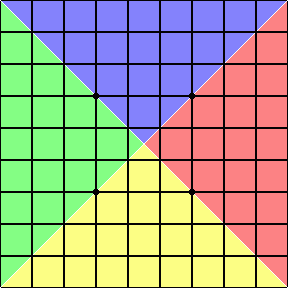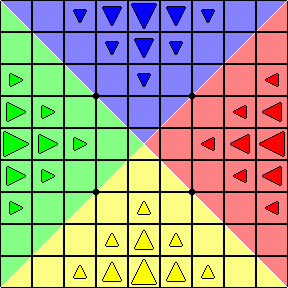Glacial Shift
By Jared B. McComb

Introduction
Glacial Shift is a four-handed Icehouse game played on
the board shown at right, and with a single stash each of red, yellow,
green, and blue (a stash contains five large, five medium and five
small Icehouse pieces). The board is similar to a Shogi board, except it has four colored
quadrants. Each quadrant contains 25 spaces, and the quadrants
overlap each other on the main diagonals of the board. The goal of
each player is to eliminate the other three.

(If you are not familiar with Icehouse pieces, you may want to look here before reading the rest of this page.)
Setup
This is the initial setup. The pieces not used in the initial setup are placed aside in the public stash and do not initially belong to anyone. Ownership of pieces in this game is decided by the direction the pieces are pointing, not necessarily by their color.
Nomenclature and Movement
A piece that is the same color as its owner is called a Royal piece. A piece that is the color to the left of its owner is called a Left piece, and similarly a piece that is the color to the right is called a Right piece. A piece which is the color opposite its owner is called a Center piece. Each of these four subsets of pieces has its own move progression. The smallest pieces are Pawns, the next largest are called Knights, and the largest pieces are called Generals. Therefore, each player starts with five Royal Pawns (small Icehouse pieces), three Royal Knights (medium Icehouse pieces), and one Royal General (a large Icehouse piece).Royal Pawns have a one-space orthogonally forward move. Royal Knights gain the additional power of moving one space diagonally, and Royal Generals may move in any of these five directions for any distance.
Center Pawns have a one-space diagonally forward move. Center Knights gain the additional power of moving one space orthogonally, and Center Generals may move in any of these six directions for any distance.
Left Pawns may move any distance orthogonally forward. Left Knights gain the additional power of moving any distance in the other three orthogonal directions, and Left Generals may also move one space diagonally.
Right Pawns may move any distance diagonally forward. Right Knights gain the additional power of moving any distance in the other two diagonal directions, and Right Generals may also move one space orthogonally.
Rules
Yellow plays first, and play passes clockwise. On your turn you may either move a piece or drop a piece from your hand onto your quadrant. All pieces capture as they move, and all captured pieces are taken in hand, as in Shogi. Also as in Shogi, pawns may not be dropped where they would be rendered immobile.The goal of each player, as stated above, is to eliminate the other three by checkmate. However, no piece is subject to the rules of check unless it is the only Royal piece inside its owner's quadrant. Therefore you are not allowed to move all of your Royal pieces out of your quadrant. It is also possible to check a player by reducing his total on-board forces to a single Royal piece (in his quadrant). This is called bare check and it carries with it a rather nice bonus for the checking player if they are able to carry out mate with it (which they usually are).
If a player is put in check, the turn immediately passes to them. If more than one player is put in check simultaneously, turn passes to the player whose normal move would fall closer to the player who just moved. For example, if Yellow checked both Green and Red simultaneously, the turn would pass to Green. After the turn, if Red was still in check, the turn would immediately pass to Red, unless Green also checked Blue on his turn, in which case the move would go to Blue instead, and then Red afterwards. In other words, with turn always going clockwise, checked players always take move priority. Perpetual check is not allowed; no player may ever recreate a previous board position. Counter-check is not allowed, either.
Because of the nature of check in this game, it may be averted in any of these four ways:
- Capture the checking piece.
- Move the checked piece out of the way.
- Drop a piece in the way of the checking piece.
- Move or drop another Royal piece into your quadrant.
- (Bare check only) Drop another piece anywhere on the board.
If a player cannot avert check on their turn, they are mated by the live player who last attacked them (not necessarily the player who last moved) and the following things happen:
- The mated piece is turned upright, and can no longer be moved or captured. If it was a promoted piece, the largest component is turned upright and the others are sent to the mating player's hand.
- The mating player receives all of the mated player's in-hand pieces and places them in his own hand.
- The mating player receives all of the mated player's pieces which are the same color as the mating player, as well as all the mated player's pieces which are in the same attacker's quadrant (except for the upright one, if applicable), and places them in his hand. In the case of promoted pieces, the player delivering mate takes only the largest components and places the others in the public stash.
- All the mated player's other pieces go to the public stash.
- In the case of bare mate, the mating player then takes all of the pawns from the public stash and places them in his hand.
- Turn passes to the player after the mated player, unless of course there is another player in check.
Promotion and Demotion
When a player advances a piece to the last three rows of the board (from his perspective, of course) then the piece is promoted. In a promotion, the smallest available larger piece is taken from the public stash and placed on the square, with the original piece inside it to show that it didn't start that way. (In other words, Pawns promote to Knights, which promote to Generals, but if there are no Knights of the correct color in the public stash, the Pawn promotes immediately to a General.) The piece must start its move outside the promotion zone and end it inside it in order to promote. Promotion is compulsory, and the piece must stay the same color.If a promotion is not possible, due to a lack of correct pieces in the public stash, then the piece stays the same and cannot be promoted on a later turn. It is therefore possible to immobilize pawns by moving them to the far end of the board when there are no promotions available. Generals do not ever promote.
When a player captures another player's promoted piece, only the smallest piece inside it is taken into their hand, and all the others are returned to the public stash. This is called demotion of captured pieces, and pieces only demote when captured.
Acknowledgments
This game was inspired first and foremost by Yonin Shogi. The ideas of quadrants where the royal pieces must stay is vaguely derived from Xiang-Qi. The idea of having a game with a public stash is taken from Martian Shogi, as is the idea of a Shogi variant using Icehouse pieces. Many of the moves of the pieces and their promotion sequences are also taken or derived from Shogi variants.Please feel free to leave comments and constructive criticisms on this page using the provided form.
Written by Jared B. McComb.
WWW page created:July 15th 2004.